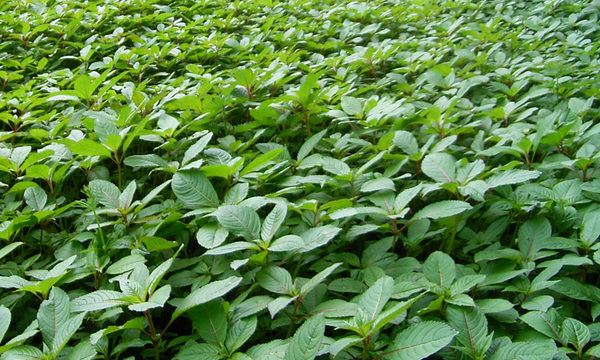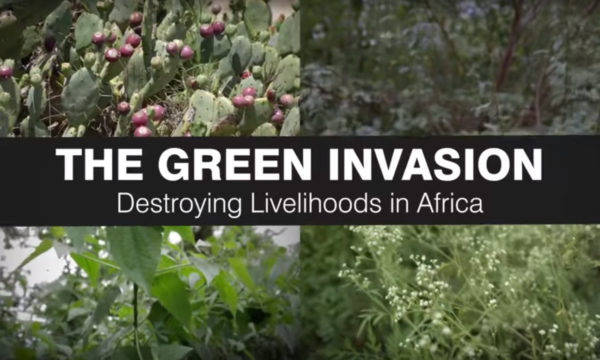
Workshop attendees: Invasive weed factsheet development. Nairobi, Kenya. February 2016.
Keen to meet colleagues and external partners in Kenya, and to learn new skills, I applied to CABI’s annual staff Development Bursary in 2015. Successful, I journeyed to Nairobi in February 2016 where I assisted with a workshop focussed on developing factsheets on invasive weed identification, management and control. These factsheets will ultimately help improve the livelihoods of farmers by reducing crop losses.
Who am I?
I am Kate Dey, a Content Editor for CABI’s Invasive Species Compendium (ISC) (kneeling front, right of image above). Sitting in the small compendia office on the second floor at Wallingford HQ, UK, I spend the majority of my time commissioning and editing datasheets. I also update distribution and pest records for the Crop Protection Compendium (CPC) and help manage the @CABI_Invasives Twitter account.
Leading up to my bursary application
In October 2015, I was asked to assist with a project which is part of an initiative known internally as the Invasives Big Push. The aim of this initiative is to stop the world’s worst invasive species undermining the livelihoods of 50 million farming families. To help achieve this aim, the project’s focus was to produce 100 factsheets on invasive weeds for East Africa (Kenya, Tanzania, Ethiopia, Malawi, Rwanda and Uganda) and Southeast Asia (Myanmar, Thailand and Vietnam) with the overarching theme of empowering farmers by providing them with clear and practical information on weed management and control. This exciting project is a collaborative one which involves CABI’s Invasives and Plantwise teams, and external partners, working together.
So I got stuck in, assisting with the prioritisation of species to be covered. They were largely prioritised by taking into account: impact on major crops (mainly maize and rice); number of countries affected by weed; and amount of information CABI already has (largely looking at the ISC and CPC) which could be repurposed and shared more widely.
I proceeded to create the first drafts, editing information from the Compendia so that it was compatible with the factsheet format required by CABI’s Plantwise Knowledge Bank (PWKB) – an online pest information resource on which the factsheets were to be hosted. Making this information available via the PWKB means it will be more readily available to extension workers who can use it to give effective advice to farmers struggling with weed infestations.
More specifically, I helped draft the first few species-specific Pest Management Decision Guides (PMDGs) which hold clear, practical, country-specific advice on pest management and control, and support Integrated Pest Management principles (IPM). These are usually produced by Plantwise but on this occasion their creation was the responsibility of the Invasives Big Push Team because of the focus on invasive weeds. Hence, Plantwise were instrumental in the creation of these factsheets, providing us with useful training and ongoing support.
The second type of factsheets produced was species-specific descriptive factsheets. The creation of these would fulfil the objective to repurpose and disseminate information from weed ID guides, produced by CABI employee Arne Witt. Along with the PMDGs, these were to be developed at two workshops in Kenya and one in Bangkok, making them country-specific in the process. Keen to be part of the development phase and to see what would become of our drafts, I applied for the development bursary in December 2015.
The workshop
I was lucky enough to attend the first four day workshop in Nairobi, Kenya, where the drafted factsheets would be developed. Attendees included specialists in weed ecology and control from a variety of research organisations and universities, and had travelled from Tanzania (2 people), Ethiopia (6 people) and within Kenya itself (6 people).
Day 1

Arne Witt, talking about impacts invasive alien species on crops
Participants were welcomed and introduced, and opening presentations were given, covering: background to the Invasives Big Push and Plantwise initiatives (by Marion Seier); introduction to factsheets and PWKB (by me); impacts of invasive alien species on crop production, and introduction to integrated pest management (IPM) principles (by Arne Witt).
Before beginning factsheet development, we needed to ask each country group what weeds they thought we should focus on. Participants were asked to complete a prioritisation table which would enable them to rank the importance of weeds in their country. It contained criteria such as area affected, crops affected, health impacts and ease of control. Species selected were those ranked 1-10 by at least two countries, luckily resulting in a large cross-over with the countries we had previously prioritised. We then started reviewing the country-specific descriptive factsheets together, asking participants to look over the drafts (some created beforehand and some created during the workshop itself) and confirm the most important common local names for each species.
Day 2
The descriptive factsheets were completed in the morning, before further presentations were given on PMDG writing (by René Eschen) and international pesticide agreements (by Sarah Thomas). We then started discussing how to write the PMDGs. Importantly, the information needed to: promote the use of preventative methods as the first line of defence; provide monitoring guidance so an infestation could be identified early on; and promote the use of the least harmful control methods if an infestation is present (i.e. non-chemical control). If these methods proved ineffective, it was essential to provide information on how to correctly use potentially harmful control methods (i.e. pesticides) safely and effectively.
The first step was to talk through the content of an existing PMDG together, in order to gain an understanding of what should go in the Prevention, Monitoring and Direct Control columns, and what restriction and limitation information was essential to include along with pesticide recommendations. We then reformed into country groups and had a go at creating a PMDG from scratch (for Parthenium hysterophorus, a weed that can not only reduce crop yields by over 90% but also poses a serious health risk to people and livestock).
After completing this task, we joined together again and listened to a representative from each country group present the PMDG they had produced. Content was debated and discussed, helping everyone further their understanding of the information required and providing inspiration by comparing differences and similarities. We then started on PMDGs for the rest of the prioritised species.
Days 3 & 4

Sarah Thomas, assisting with PMDG development
During the final days, PMDG drafts were reviewed, refined and added to. Along with Marion, René, Arne, and Sarah, I sat with the participants, answering their questions on what information was required, where it should be placed and how to make it clear. We assisted with entering the text into the forms and helped look up pesticide information; checking whether they were on Plantwise’s Red List (containing internationally restricted/not to be used pesticides) and on the nationally approved lists.
Some PMDGs were placed on the walls so groups could gain ideas from each other’s factsheets, particularly since many management and control methods would be the same for each country. For this reason also, PMDGs were rotated around the groups, so that as the factsheets were circulated participants added to and edited what a country group before them had written, thereby maximising efficiency. By the final day 18 weed species had been covered, and 33 PMDGs and 30 descriptive factsheets had been produced – a fantastic outcome which was thanks to an engaging, friendly and hard-working group.
What will happen next?
The factsheets will now need to pass through a review process, whereby content will be edited by Plantwise and a weed specialist will validate the information. The final versions will be uploaded the PWKB, a key resource for extension workers, called Plant Doctors, who advise farmers on what action to take when a pest is impacting on their crop. Farmers bring their affected crop along to a local Plant Clinic where the Plant Doctor makes a diagnosis (find out more at www.plantwise.org). The factsheets will provide Plant Doctors with the tools they need to help farmers loose less of what they grow to crop weeds, increasing the amount of food they can sell and eat and ultimately improving their livelihoods.
What did I get out of it?
Firstly, I really enjoyed working with such dedicated and passionate participants, listening to them talk about their research and experience and how much they care about helping farmers. Many of them had farming backgrounds, and/or had close friends and family who were farmers, so they had a good understanding of the challenges they face.
Two particular subjects that we discussed with participants stuck with me; firstly, the presence and growing dominance of women in farming businesses. More and more men are leaving farms to go to the cities and towns to find jobs, which is not surprising when you consider the back-breaking work, high running costs, unpredictable outputs and slim profit margins. 60% of pre-harvest labour in Africa is hand weeding, mostly by women and children (who often have to leave school during peak weeding periods). 100 million women in Africa spend 20 billion hours weeding every year. Secondly, the extent to which pesticides are used unsafely and ineffectively is huge, with many farmers developing health problems from incorrect use, such as not wearing protective clothing or using too high a concentration. More than one participant mentioned that many farmers who use pesticides in Africa don’t eat the crops they spray because even they aren’t sure that they’re safe. Furthermore, there was a story of one farmer not being able to get their beans to market, consequently feeding those beans to their livestock, and their livestock dying from poisoning as a result.
It was also great to make new friendships with CABI staff members who I may not have been able to meet through my usual line of work. It was a really nice experience walking into a CABI office I’d never been to but still feeling welcome and a sense of familiarity. We’re often reminded of the ‘One CABI’ ethos at work but those words mean so much more when you actually experience it. It was not just lovely to meet Kenyan staff, but also to work with Marion, René and Sarah from Egham, UK.
Summary
Overall, it was fantastic to be part of a project with the purpose of improving people’s lives. These factsheets will directly help farmers to more effectively manage and control invasive weeds, improving yields and so resulting in more food and income for their families. The workshop experience was a reminder that there is still more work that needs to be done, but that by working together we can really make a difference.
Related News & Blogs
Busy in biocontrol: spotlight on weed researcher Jennifer Andreas
Meet Jennifer Andreas, who has collaborated with CABI on a number of biological control projects since 2000, in this profile originally published by the North American Invasive Species Management Association (NAISMA). Field Dispatch: Jennifer Andreas J…
29 October 2020




